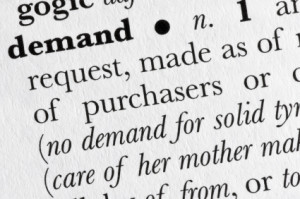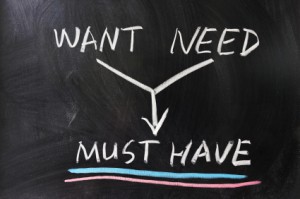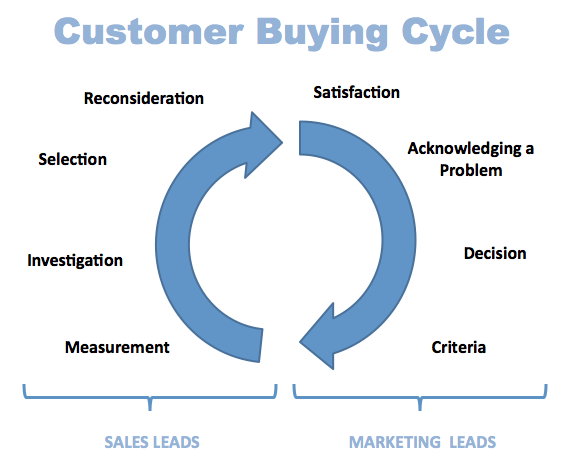by Glen Springer | Apr 3, 2013
 In January, Forbes called 2013 the ‘year of the customer’, and when it comes to B2B sales, this statement could not be more true. The customer, not the seller, now controls B2B buying cycles. This means that your marketing strategy and content must be based on a full understanding of who your customer is and structured around meeting the customer on their own terms.
In January, Forbes called 2013 the ‘year of the customer’, and when it comes to B2B sales, this statement could not be more true. The customer, not the seller, now controls B2B buying cycles. This means that your marketing strategy and content must be based on a full understanding of who your customer is and structured around meeting the customer on their own terms.
In order to meet the customer where they’re at, you need to have a clear understanding of where he or she is in the buying cycle for your product or service. Knowing the stage of the buying cycle the prospect is at tells you what marketing content is appropriate to move them to further down the pipe. Giving someone the wrong content at the wrong time will confuse or annoy your prospect, neither of which is an effective sales strategy.
Just as you would not serve crème brulee as a breakfast dish, you should not give a prospect a video of a complex software demo after their first interaction with your company. You need to provide your prospect with a full menu of content options and let their behaviors inform you of what they would like to be served. Using a marketing automation solution, you can watch prospects interact with different “menu options” and gauge if they are in the mood for breakfast or lunch.
Following this metaphor, here are the different stages of the buying cycle for B2B customers along with what type of marketing content is appropriate for each stage.
Stage #1: Breakfast
Prospect expresses interest.
Content types: basic info about value proposition, “welcome” emails, educational blogs, best practices articles, introductory videos
Stage #2: Lunch
Prospect is engaging.
Content types: Invitations to webinars/webcasts, demo videos, segmented content based on specific page views
Stage #3: Dinner
Prospect is ready to make a decision.
Content types: case studies, software demonstrations, service/product options, feature comparisons, white papers, testimonials, pricing
Stage #4: Dessert
Prospect becomes an ongoing customer.
Content types: new product/service info, review/testimonial requests, newsletters, requests for customer data updates
These four stages (or meals) of the buying cycle comprise the majority of the B2B marketing process. However, the problem remains: what if the prospect isn’t hungry?
In cases where the prospect is showing no interest in digesting your content, you need to prove to them how great it tastes. Maybe your prospect is hungry, but you haven’t offered them anything appealing yet. These prospects need to be nurtured with content like surveys to better assess their specific business needs. Prospects that aren’t hungry also need to be given incentives to engage in your content; offering a promotion of some kind may be able to initiate reengagement (e.g. “Today Only: FREE Samples!”).
In summary, we have gone over the various stages of the B2B customer buying cycle and explained what marketing content each stage necessitates. If you have any questions or would like to know more about B2B buying cycles or content marketing, please contact us.
by gabriel_sales | Mar 27, 2013
 Putting leads at the front end of your sales pipe and hoping for the best is not going to work for B2B sales in 2013. Every B2B company needs to have a well-thought out and clearly defined process for generating demand that includes content marketing and sales lead management.
Putting leads at the front end of your sales pipe and hoping for the best is not going to work for B2B sales in 2013. Every B2B company needs to have a well-thought out and clearly defined process for generating demand that includes content marketing and sales lead management.
Before we dive into what a company needs to do in order to generate demand, we need to ensure that there is a clear understanding of the differences between demand and lead generation. If you were to do a quick web search for the two terms you might get back a few dozen definitions. Let’s take a look at the real differences between the two disciplines.
Lead Generation vs. Demand Generation
For Gabriel Sales, lead generation is about putting targets into your sales funnel at the very front end. A lead is getting an individual from a company that is interested in learning more into your sale funnel. Demand generation is the process of moving that lead through the sales and marketing process, educating the buyer so they are interested and ready to speak to sales.
Demand Generation & Sales Lead Management
B2B demand generation’s job is therefore to drive and close business. In order to close business, successful B2B demand generation requires sales content that educates, verifies and finally convinces the customer to transact. That content must be integrated with insights about your customer buying cycle, so that relevant and valuable content reaches your prospect at the right times. These insights could include knowledge on whether your ideal customer prefers short YouTube videos or long whitepapers. This is what successful sales lead management is; knowing your lead well enough to give them the right information in the right form at the right time.
If you add the sales content and customer insights to the right technology to track digital consumption, your well-designed demand generation strategy will give your team the ability to:
- Source marketing qualified leads
- Take leads from marketing qualified to sales qualified and then engage
- Nurture leads not ready to buy (until they are)
- Supply the closer with content required to take to proposal and close
B2B demand generation involves your reps and marketers having the right conversations and sharing the right information in the right channel at the right time in the customers buying cycle.
If you would like help with any part of this strategy, Gabriel Sales has the experience and expertise to help you jumpstart this process and reach your business goals. We can help you take the content you create to support your reps and repurpose it across digital platforms and social media, so your customers can find you and you sales reps have third-party verification ground cover. At Gabriel Sales, we can help you create a B2B demand generation engine with a seamless sales process that integrates sales reps, leverages digital content and improves sales results with the right sales technologies stack.
For more information on demand generation for sales lead management, please contact us.
by gabriel_sales | Feb 6, 2013
 This blog offers some tips for your B2B marketing strategy regarding how to make your blog work for you.
This blog offers some tips for your B2B marketing strategy regarding how to make your blog work for you.
You may have heard by now that your B2B company needs to be blogging. As a B2B sales and marketing outsourcing company that specializes in demand generation, we would agree. But we only agree to the extent that you are blogging with purpose. Blogs for B2B sales can and should be leveraged in various ways to achieve your company’s sales goals.
To begin, if you have not looked at your blog strategy as a marketing strategy, we recommend you look through a sales/marketing lens. Several things to take into account are:
SEO—B2B companies often forget about their blog as a tool for improving SEO. Because Google and most other search engines now filter their results by relevancy, the more relevant you blog content is for your customers, the higher it will show up on search results pages. Our experience as a sales and marketing outsourcing company has also shown that aligning the input of your sales reps with your keyword research ensures you get the full value from inbound leads.
Thought Leadership—While some of the more traditional marketers may not agree, we believe your sales reps are a great source of content in terms of thought leadership. Your sales reps spend all day on the phone talking to customers, answering their questions and solving their problems. By drawing upon these conversations and turning them into blogs focused on answering FAQs and solving problems, you can establish your business as a thought leader within your industry.
Email Sign up—Every B2B sales companies’ blog should have a place to sign up/follow via email. This is the best and easiest way to leverage your blog for lead generation. The key to getting people to sign up for your blog is establishing yourself as a thought-leader and/or providing your prospects something of value.
Calls to Action—Leveraging your blog for lead generation can also be done using calls to action. Since your prospect has already shown interest in clicking on your blog, you should make it easy for them to reach out to you. All of your blog posts should include a highly visible place where they can contact someone on your sales team. Just be careful that your blog does not appear as one big advertisement for your company.
Recycling Old Content—Many companies do not take advantage of the long-shelf life of their sales and marketing content. Because of the way the Internet works today, content still capable of providing value becomes hidden from your prospects or disappears completely. A B2B blog is a great place to make use of this old content by providing links back to old posts in your newer ones. Another way to use old content for blog posts is to ask your sales reps for any independently created content they may have lying around.
If you would like to learn more about how a sales marketing company can help you improve your B2B marketing strategy for a fatter pipe and more closed revenue, please feel free to contact us for a free initial strategy conversation.
If you are having cultural issues between sales and marketing we suggest you check out B-to-B Demand Generation Requires Sales and Marketing Alignment. You can also checkout our Free White Paper on 10 Tips and What to Avoid to Sell Smarter and Faster.
by gabriel_sales | Jan 23, 2013
 Landing page design is all the rage for B2B demand generation tactics in 2013. However, having glitzy graphics or a colorful layout will only get you so far. What we have seen in our work as a B2B demand generation and sales and marketing outsourcing company is that the content of the page is much more important than what it looks like.
Landing page design is all the rage for B2B demand generation tactics in 2013. However, having glitzy graphics or a colorful layout will only get you so far. What we have seen in our work as a B2B demand generation and sales and marketing outsourcing company is that the content of the page is much more important than what it looks like.
This blog gives some simple tips on how to craft persuasive and successful landing pages. If this content is a little too basic for your needs we invite you to check out our B2B Demand Generation Blog Topic area or our B2B Demand Generation Knowledge Center.
Five tips for creating landing pages for B2B demand generation:
- One landing page is NOT enough—each product, service or campaign you have should have a landing page to match. Marketing automation tools like Pardot can simplify this process.
- Match the content to the keywords—the landing page should be directly related to the link your prospect clicked on to get there. Do not make your customers search for what they want.
- Make your goal obvious—decide what you want your potential customer to do on each landing page, and then make it easy for them to do so. The goal should almost always be B2B demand generation of sales qualified leads.
- Keep it simple and transparent—do not overwhelm your visitor with a lot of different options or complex language. For example, say something like, “If you fill out this form, then we will send you a white paper about a specific topic.”
- Use keywords for SEO—for search optimization, you cannot overuse keywords (the keyword for this page is B2B demand generation). Using the right keywords in the right places will result in an SEO lift for your entire site.
For more information on building effective landing pages or B2B demand generation tactics, please visit our blog titled “The Importance of Landing Pages” or contact Gabriel Sales directly. For a quick overview of how Gabriel Sales creates and integrated inbound and outbound machine CLICK HERE to view our How To Build a B2B demand generation engine. To schedule an appointment for a free pipeline velocity review from Gabriel Sales, please click here.
by gabriel_sales | Dec 4, 2012

Unlike Facebook and Google+, which are used by both individuals and businesses, LinkedIn is built primarily for business professionals. The people who use LinkedIn are generally older and more affluent than those on Facebook or Twitter and are using the site primarily for business connections. For these reasons, LinkedIn is extremely important for B2B sales and marketing.
Here are some tips on using LinkedIn effectively for B2B marketing:
- Create a Page for Your Company. Like Facebook, your page is the platform from which you do all of your communication. You cannot get around having one if you want to be successful on LinkedIn.
- Customize Your Page. Give your readers something to look at by adding photos and videos to your page. LinkedIn also lets you create tabs for different topics like specific products or services, career opportunities and a description of what you do.
- Add Presentations. LinkedIn gives you the ability to upload any presentations or slideshows you may have to your page. They offer a few different applications for this, but PowerPoint and SlideShare are the most common.
- Use Polls to Attract. LinkedIn also has an app that lets you create polls. You can use this feature to gauge opinion on a new product or industry trend, and simply to engage with your audience. If your conversation is interesting enough, you will attract new potential customers.
- Add Blog and Twitter Feeds. LinkedIn has a feature that allows you display feeds from different sites. The two main feeds you want to add are your Twitter and blogs feeds. This makes it possible to have several different flows of information all aggregated in the same place, making everything that much easier for your potential customer to find.
- Create a LinkedIn Group. Like ‘circles’ on Google+, groups on LinkedIn allow for people to come together to discuss a certain issue or topic. You should create a LinkedIn group related to your industry and take part in the conversation. This is a great place to discuss best practices and industry insights.
- Promote Your Group. Once you have a group, you want people to know about it. Use all the media platforms you have to get the word out about your group and invite people to join.
- Participate in Different Groups. You should not only care about your group on LinkedIn. Your customers and potential customers are involved in other groups, and you need to interact with them in those places as well. Remember, communication works two ways, and you need to participate in the conversation.
For more tips from Gabriel Sales on using LinkedIn for B2B marketing, please feel free to contact us.

by gabriel_sales | Nov 29, 2012
Understanding the difference between a Sales Cycle vs. Buying Cycle may be the most critical shift an organization needs to make to see significant and sustained revenue growth, especially for complex or highly competitive sales.
In a nutshell, the Sales Cycle is how your company looks at moving deals through their own sales pipe and sales process to close deals. Typically the flow looks something like a lead, marketing qualified lead, sales qualified leads, needs analysis, proposal, negotiation, verbal, and closed. This is a company centered view.
A buying cycle is looking at your sales cycle from what the customer needs. Probably the best example we have seen of a buying cycle is from Robert Jolles book Customer Centered Selling. Below is our brief explanation of how we look at this cycle, addressing some of the implications it has for us as an outsourced sales and marketing company with how we divide the sales and marketing functions.

Phase 1 – Intention to Buy
- The buyer starts satisfied with their current solution
- The buyer acknowledges to themselves that they are not satisfied
- The buyer makes the decision to do something about it
- The buyer starts to think about “what are the criteria” to consider moving forward
As a lead generation and a demand generation company, we understand that intention is meaningless without action. The world is full of people with great intentions that never actually take any action. Your job as a sales person and marketer is to understand that your first task in generating demand for your solution is to help educate a buyer on the “criteria” they need to consider. You need to appreciate that given a choice, most buyers will sit on the fence for as long as possible. They want to move forward, they know it’s good for them to move forward, so you need to help educate the buyer enough so they do in fact move forward. Your first job as a sales and marketing professional is to inspire and catalyze the desire that gets your buyer to move from the passive buying process to the active buying process. More and more, this is becoming the function of your content marketing and inside team.
Phase 2 – Active Buying
- The buyer needs to figure out how to measure the solution to: justify the purchase, understand the impact of doing nothing vs. changing, see the impact on topline, recognize the implications for bottom line, feel subjective relief of pain or risk
- The buyer investigates deeply, typically with short list of solutions and a deep dive into one or more solutions
- Selection is made; a front-runner is chosen
- The buyer reconsiders their decision
During the “Active” buying process, your sales team is typically on point. It’s at this point that marketing should take a back seat – with one exception: marketing needs to continue to support the sales team with the content they need to help deal with the reconsideration phase of the sales cycle. Your marketers need to be prepared to help the buyer remember why they were no longer satisfied and embarked on their buying cycle in the first place.
 In January, Forbes called 2013 the ‘year of the customer’, and when it comes to B2B sales, this statement could not be more true. The customer, not the seller, now controls B2B buying cycles. This means that your marketing strategy and content must be based on a full understanding of who your customer is and structured around meeting the customer on their own terms.
In January, Forbes called 2013 the ‘year of the customer’, and when it comes to B2B sales, this statement could not be more true. The customer, not the seller, now controls B2B buying cycles. This means that your marketing strategy and content must be based on a full understanding of who your customer is and structured around meeting the customer on their own terms.
 Putting leads at the front end of your sales pipe and hoping for the best is not going to work for B2B sales in 2013. Every B2B company needs to have a well-thought out and clearly defined process for generating demand that includes content marketing and sales lead management.
Putting leads at the front end of your sales pipe and hoping for the best is not going to work for B2B sales in 2013. Every B2B company needs to have a well-thought out and clearly defined process for generating demand that includes content marketing and sales lead management. This blog offers some tips for your B2B marketing strategy regarding how to make your blog work for you.
This blog offers some tips for your B2B marketing strategy regarding how to make your blog work for you. Landing page design is all the rage for B2B demand generation tactics in 2013. However, having glitzy graphics or a colorful layout will only get you so far. What we have seen in our work as a B2B demand generation and sales and marketing outsourcing company is that the content of the page is much more important than what it looks like.
Landing page design is all the rage for B2B demand generation tactics in 2013. However, having glitzy graphics or a colorful layout will only get you so far. What we have seen in our work as a B2B demand generation and sales and marketing outsourcing company is that the content of the page is much more important than what it looks like.


